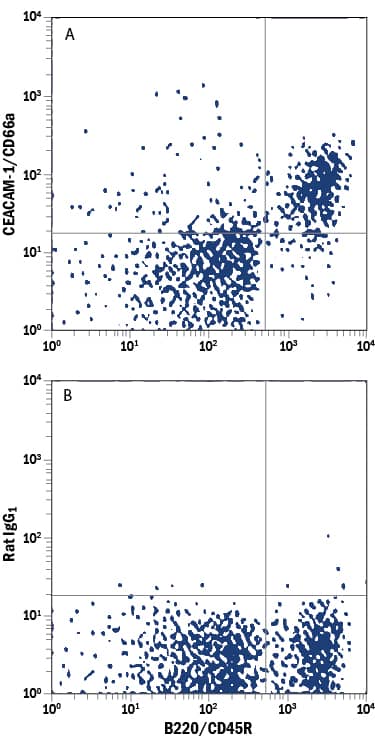Mouse CEACAM-1/CD66a APC-conjugated Antibody
R&D Systems, part of Bio-Techne | Catalog # FAB6480A


Key Product Details
Species Reactivity
Applications
Label
Antibody Source
Product Specifications
Immunogen
Glu35-Gly428
Accession # P31809
Specificity
Clonality
Host
Isotype
Scientific Data Images for Mouse CEACAM-1/CD66a APC-conjugated Antibody
Detection of CEACAM-1/CD66a in Mouse Splenocytes by Flow Cytometry.
Mouse splenocytes were stained with Rat Anti-Mouse B220/CD45R PE-conjugated Monoclonal Antibody (Catalog # FAB1217P) and either (A) Rat Anti-Mouse CEACAM-1/CD66a APC-conjugated Monoclonal Antibody (Catalog # FAB6480A) or (B) Rat IgG1Allophycocyanin Isotype Control (Catalog # IC005A). View our protocol for Staining Membrane-associated Proteins.Applications for Mouse CEACAM-1/CD66a APC-conjugated Antibody
Flow Cytometry
Sample: Mouse splenocytes
Formulation, Preparation, and Storage
Purification
Formulation
Shipping
Stability & Storage
- 12 months from date of receipt, 2 to 8 °C as supplied.
Background: CEACAM-1/CD66a
CEACAM-1 (Carcinoembryonic Antigen-related Cell Adhesion Molecule 1), also known as BGP-1, CD66a and MHVR1, is a 110-120 kDa member of the CEACAM subfamily, CEA family of proteins. It has a wide expression pattern, being found on neutrophils, dendritic cells, endothelial cells, colonic epithelium and hepatocytes. It mediates cell adhesion, and appears to regulate insulin levels and signaling by interacting with the insulin receptor. It also demonstrates proangiogenic effects by inducing endothelial cells to proliferate and form capillary-like tubules. Finally, CEACAM-1 is a known receptor for mouse hepatitis virus. Mature mouse CEACAM-1 is a 487 amino acid (aa) type I transmembrane glycoprotein. Its contains a 394 aa extracellular region (aa 35-428) that shows one V-type (aa 35-142) and three C2-type (aa 147-411) Ig-like domains, plus a 74 aa cytoplasmic domain. Three alternate splice forms exist. One contains a four aa substitution for aa 455-521, a second shows a Gln substitution for aa 142-322, and a third possesses a combination of the first two splice patterns. CEACAM-1 forms homodimers. Over aa 35-428, mouse CEACAM-1 shares 56% and 70% aa identity with human and rat CEACAM-1, respectively.
Long Name
Alternate Names
Gene Symbol
UniProt
Additional CEACAM-1/CD66a Products
Product Documents for Mouse CEACAM-1/CD66a APC-conjugated Antibody
Product Specific Notices for Mouse CEACAM-1/CD66a APC-conjugated Antibody
For research use only